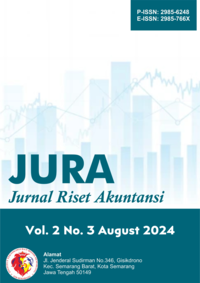Pengaruh Fraud Hexagon Model Terhadap Indikasi Financial Statement Fraud
DOI:
https://doi.org/10.54066/jura-itb.v2i3.2254Keywords:
Financial Statement Fraud, Stimulus, Opportunity, Rationalization, CapabilityAbstract
The purpose of this study was to test and determine the effect of stimulus, opportunity, rationalization, capability, ego, and collusion on indications of financial statement fraud. This study uses purposive sampling in determining the sample with secondary data sources in the form of financial reports and annual reports of infrastructure companies listed on the Indonesia Stock Exchange (IDX) and the pages of each company during 2020 - 2022 with the final number of observations totaling 143 data. This study uses panel data regression analysis techniques in the Eviews 13 data processing application. The results of hypothesis testing in this study indicate that stimulus and opportunity have a positive effect on indications of financial statement fraud. While rationalization, capability, ego, and collusion do not affect indications of financial statement fraud. This research has practical implications for companies, investors, governments, and auditors in examining solutions to crucial problems in the stimulus and opportunity variables that indicate financial statement fraud because it is an evaluation of the level of ROA and NOIR proxies..
References
ACFE Global. (2022). Occupational fraud 2022: A report to the nations. https://legacy.acfe.com/report-to-the-nations/2022/
Akbar, R. N., Zakaria, A., & Prihatni, R. (2022). Financial statement analysis of fraud with hexagon theory fraud approach. Jurnal Akuntansi, Perpajakan, dan Auditing, 3(1), 137–161. http://pub.unj.ac.id/journal/index.php/japaDOI:http://doi.org/XX.XXXX/JurnalAkuntansi,Perpajakan,danAuditing/XX.X.XXhttps://doi.org/xx.xxxxx/JAPA/xxxxx
Beneish, M. D. (1999). The detection of earnings manipulation. Financial Analysts Journal, 55(5), 24–36. http://www.jstor.org/stable/4480190
Cressey, D. R., & Abrahamsen, D. (1953). Who are the guilty? A study of education and crime by David Abrahamsen. The Journal of Criminal Law, 43(5), 562–563. https://www.jstor.org/stable/1139658
Ginting, R., Aminah, S., & Hidayah, R. Al. (2021). Pendidikan anti korupsi (Andriyanto, Ed.; 1st ed., Vol. 1). Penerbit Lakeisha.
Handayani, J. R., Nurcahyono, N., Saadah, N., & Winarsih. (2023). Hexagon fraud: Detection of fraudulent financial statement in Indonesia. In Proceedings of the International Conference on Business, Accounting, Banking, and Economics (ICBABE 2022) (Vol. 240, pp. 263–276). Atlantis Press. https://doi.org/10.2991/978-94-6463-154-8_24
Handoko, B. L., & Tandean, D. (2021). An analysis of fraud hexagon in detecting financial statement fraud (empirical study of listed banking companies on Indonesia Stock Exchange for period 2017-2019). ACM International Conference Proceeding Series, 93–100. https://doi.org/10.1145/3457640.3457657
Howarth, C. (2011). The fraud pentagon: Considering the five elements of fraud. The CPA Journal. https://scholar.google.com/scholar?hl=id&as_sdt=0%2C5&q=The+fraud+pentagon%3A+considering+the+five+elements+of+fraud&btnG=
Jensen, M. C., & Meckling, W. H. (1976). Theory of the firm: Managerial behavior, agency costs and ownership structure. Journal of Financial Economics, 3(4), 305–360. Q North-Holland Publishing Company.
Julia, J., & Yunita, A. (2022). The effect of hexagon fraud in detecting fraud financial statements (empirical study on financial sector companies listed on the Indonesia Stock Exchange 2017-2021). International Journal of Multidisciplinary: Applied Business and Education Research, 3(10), 2112–2124. https://doi.org/10.11594/ijmaber.03.10.23
Machali, I. (2021). Metode penelitian kuantitatif: Panduan praktis merencanakan, melaksanakan dan analisis dalam penelitian kuantitatif (A. Qurani Habib, Ed.; 1st ed., Vol. 3). UIN Sunan Kalijaga Yogyakarta. https://id.zlibrary-asia.se/book/27026374/9255b9/metode-penelitian-kuantitatif-panduan-praktis-merencanakan-melaksanakan-dan-analisis-dalam-penelit.html
Miftahul Jannah, V., Andreas, & Rasuli, M. (2021). Pendekatan Vousinas fraud hexagon model dalam mendeteksi kecurangan pelaporan keuangan. Studi Akuntansi dan Keuangan Indonesia, 4(1), 1–16.
Nadziliyah, H., & Primasari, N. S. (2022). Analisis fraud hexagon terhadap financial statement fraud pada perusahaan sektor infrastruktur, utilitas dan transportasi. Accounting and Finance Studies, 2(1), 21–39. https://doi.org/10.47153/afs21.2702022
Nindito, M. (2018). Financial statement fraud: Perspective of the pentagon fraud model in Indonesia. Academy of Accounting and Financial Studies Journal, 22(3).
Nurbaiti, A., & Putri, A. A. (2023). Mendeteksi kecurangan laporan keuangan menggunakan teori fraud hexagon. Jurnal Studi Akuntansi dan Keuangan, 6(1).
Purwohedi, U. (2022). Metode penelitian (Prinsip dan praktik) (RAS, Ed.; 1st ed., Vol. 1). Raih Asa Sukses (RAS). www.penebarswadaya.co.id
Rahmatika, D. N. (2020). Fraud auditing: Kajian teoretis dan empiris (D. Novidiantoko, A. Rasyadany, & A. Y. Wati, Eds.; 1st ed.). Deepublish Publisher. www.penerbitdeepublish.com
Ross, S. A. (1973). The economic theory of agency: The principal’s problem. American Economic Association, 63(2), 134–139.
Saparuddin, Suhud, U., Hamidah, Ulupui, I., Purwohedi, U., & Zulaihati, S. (2022). Metodologi penelitian bisnis (Alviana, Ed.; 1st ed., Vol. 1). Samudra Biru (Anggota IKAPI).
Shapiro, S. P. (2005). Agency theory. Annual Review of Sociology, 31, 263–284. https://doi.org/10.1146/annurev.soc.31.041304.122159
Sihombing, T., & Eirene Panggulu, G. (2022). Fraud hexagon theory and fraudulent financial statement in IT industry in ASEAN. Jurnal Reviu Akuntansi dan Keuangan, 12(3), 524–544. https://doi.org/10.22219/jrak.v12i3.23334
Skousen, C. J., Smith, K. R., & Wright, C. J. (2009). Detecting and predicting financial statement fraud: The effectiveness of the fraud triangle and SAS No. 99. Advances in Financial Economics, 13, 53–81. https://doi.org/10.1108/S1569-3732(2009)0000013005
Sukmadilaga, C., Winarningsih, S., Handayani, T., Herianti, E., & Ghani, E. K. (2022). Fraudulent financial reporting in ministerial and governmental institutions in Indonesia: An analysis using hexagon theory. Economies, 10(4). https://doi.org/10.3390/economies10040086
Summers, S. L., & Sweeney, J. T. (1998). Fraudulently misstated financial statements and insider trading: An empirical analysis. The Accounting Review, 73(1), 131–146. http://www.jstor.org/stable/248345
Tarjo, T., Anggono, A., & Sakti, E. (2021). Detecting indications of financial statement fraud: A hexagon fraud theory approach. Akrual: Jurnal Akuntansi, 13(1), 119–131. https://doi.org/10.26740/jaj.v13n1.p119-131
Vousinas, G. L. (2019). Advancing theory of fraud: The S.C.O.R.E. model. Journal of Financial Crime, 26(1), 372–381. https://doi.org/10.1108/JFC-12-2017-0128
Wolfe, D. T., & Hermanson, D. R. (2004). The fraud diamond: Considering the four elements of fraud. https://digitalcommons.kennesaw.edu/facpubs







